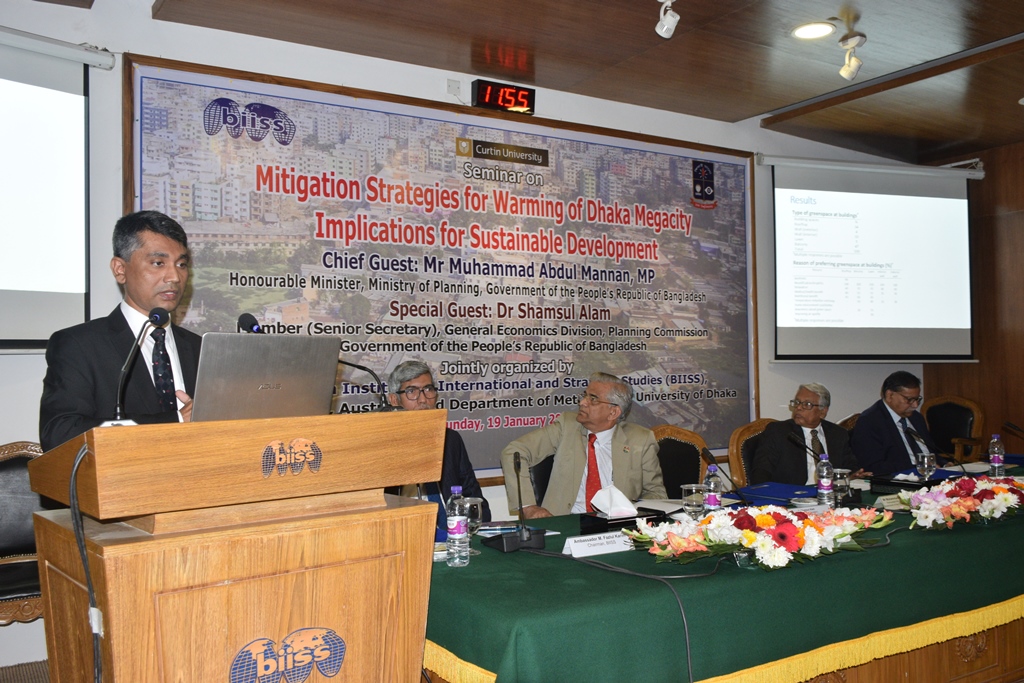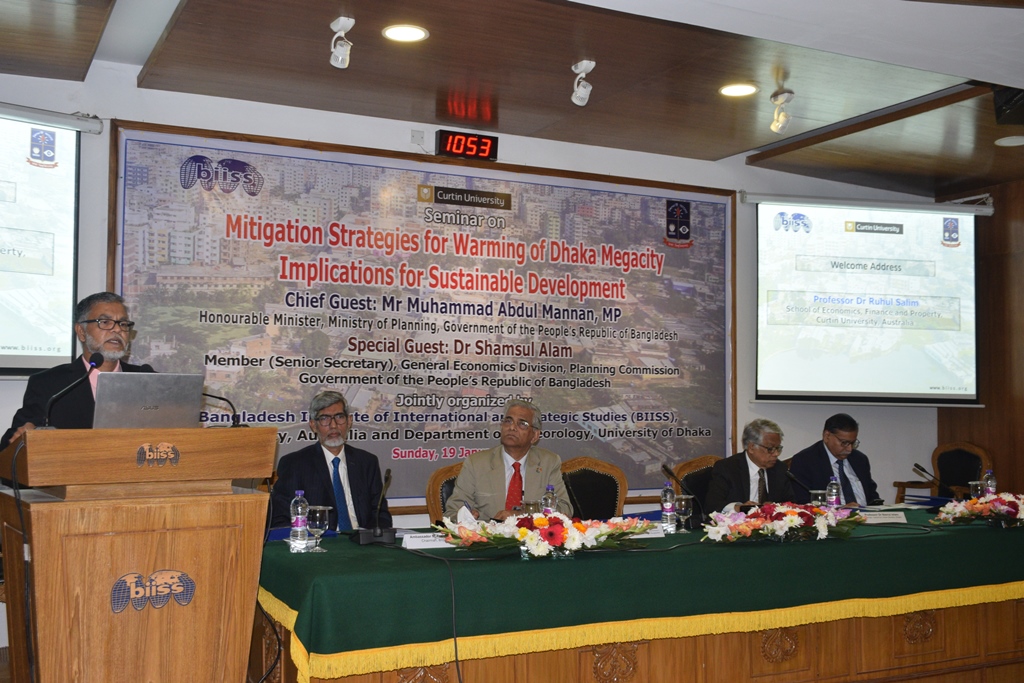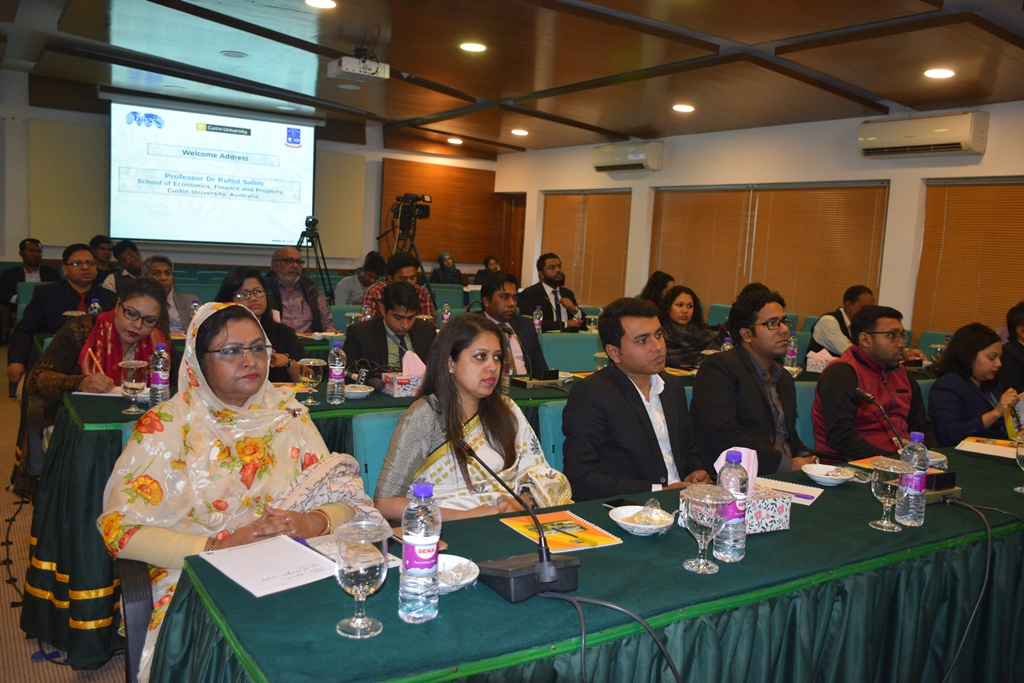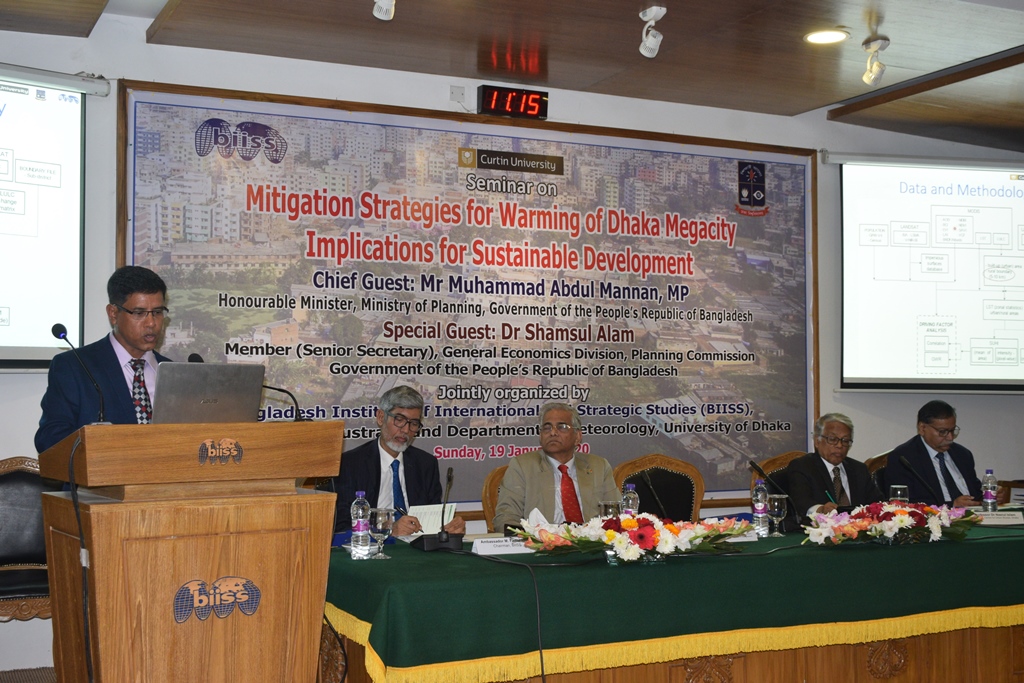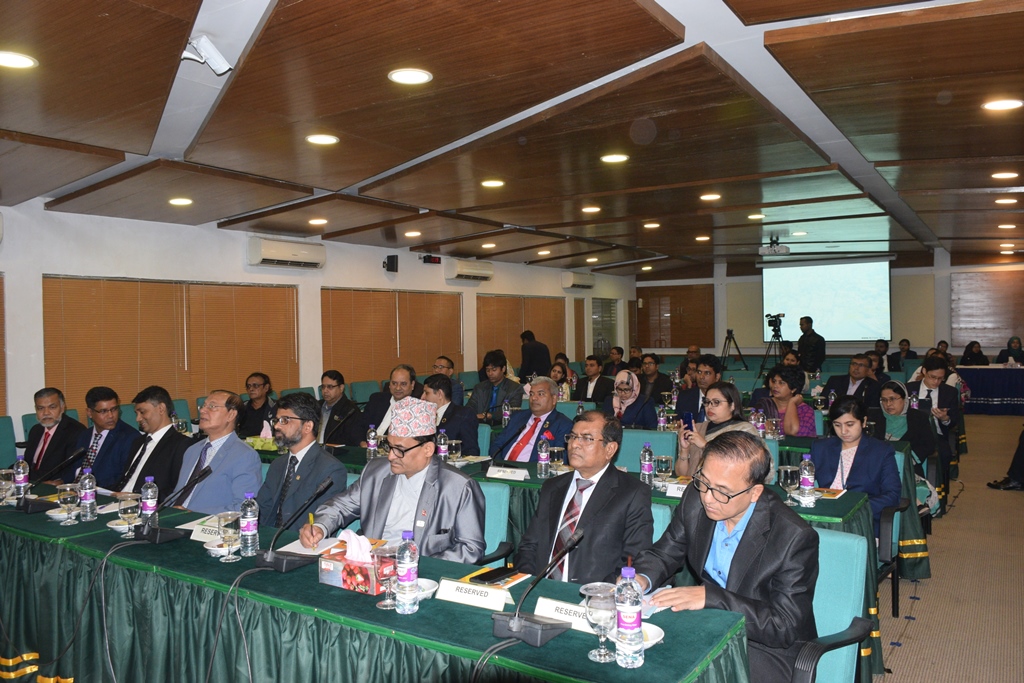Seminar on Mitigation Strategies for Warming of Dhaka Megacity Implications for Sustainable Development on 19 January 2020
DATE: 2020-01-19
Bangladesh Institute of International and Strategic Studies (BIISS) in collaboration with Curtin University, Australia, and Department of Meteorology, University of Dhaka organized a seminar on “Mitigation Strategies for Warming Dhaka Megacity: Implication for Sustainable Development” on 19 January 2020 at BIISS Auditorium. The seminar is part of the research being jointly undertaken by the aforementioned institutes under the funding of the World Bank’s “Innovation Funding and Global Partnership for Sustainable Development Data” initiative. Dr Shamsul Alam, Member (Senior Secretary), General Economics Division, Planning Commission, Government of the People’s Republic of Bangladesh was present as special guest for the occasion. Professor Dr Nazrul Islam, Chairman, Centre for the Urban Studies, Dhaka chaired the seminar. Ambassador M. Fazlul Karim, Chairman, BIISS and Professor Dr Ruhul Salim, School of Economics, Finance and Property, Curtin University, Australia delivered the welcome address.
Welcome Address
Ambassador M. Fazlul Karim
Chairman, Bangladesh Institute of International and Strategic Studies
Ambassador M. Fazlul Karim, Chairman, BIISS, remarked on the various impact of climate change on Bangladesh. He particularly stressed the impacts of air pollution and urban warming in Dhaka city, the intense heat waves which are creating severe health issues for humans, especially children and the elderly. He suggested taking long term mitigation approaches to solving the deep-rooted problem of urban heating. Creative solutions, such as greening or urban rooftops and energy-efficient practices have to be encouraged among the city dwellers. He also emphasized on the investing in ‘green’ infrastructure and using new and innovative concepts of ‘city forest’ and ‘carbon-capturing’. He noted that while planning for a city like Dhaka, wetland conservation and construction of water reservoirs must get priority. He concluded by stating that the planning a large city such as Dhaka must be done in a holistic manner with the participation of all stakeholders in order to solve the environmental problems faced by the city successfully and sustainably.
Professor Dr Ruhul Salim
School of Economics, Finance and Property, Curtin University, Australia
Professor Dr Ruhul Salim, School of Economics, Finance and Property, Curtin University, Australia stressed on the changes in the urban temperatures due to climate change. He said that the city of Dhaka has faced unprecedented growth of high rise building in the last decades but due to the unplanned nature of development, it has lost most of its green and blue space. He remarked that it was unfortunate that Bangladesh could not develop another major park within the Dhaka city since its independence.
Keynote Presentations:
Dr Ashraf Dewan
School of Earth and Planetary Sciences, Curtin University, Australia
In his presentation, Dr Ashraf Dewan covered rationale, research questions, the scientific basis of temperature rise in Dhaka, its severity, intensity and magnitude as well as mitigation measures to reduce the consistent warming of Dhaka megacity. The study took place at two levels. The meso level includes the Dhaka Metropolitan Development Plan Areas. The Microscale includes Dhaka Metropolitan Area (DMA).
He added that urban areas occupy 4-5 per cent of the earth’s surface but an important driver for 75 per cent of global CO2 emissions, local warming, urban heat island (UHI), and global climate change, loss of arable lands, deterioration of green and blue spaces and depletion of human health and well-being. Indeed, heatwaves popularly known as local warming are linked with Urban Heat Island effects.
He then talked about the research questions of the study. The research questions are: How land-use change and demographic shifts are associated with the Spatio-temporal pattern of the UHI effect? What are the major factors influencing the UHI effect at mesoscale? Are there any spatiotemporal variations? How and to what extent do urban morphology, material surfaces and land use and urban greenery indicators affect Dhaka’s microclimate? What is the role of building materials in elevating local temperatures? What are the costs-benefits of introducing self-sustaining green spaces and green roofs of mitigating UHI? What are the implications for government policies on land use zoning and practical, effective strategies for mitigating excessive urban warming?
Describing the methodology of the study, he stated that the study used more than 70,000 images spanning from 2000 to 2018. To understand the variation of temperature over time and scale, many analyses had been done. One of them was correlation matrix and geographically weighted regression to understand how at the meso and micro level climate is changing, what the driving factors are and what can be done to reduce the heat. The study also derived the MODIS multitemporal data of the land surface temperature from 2002 to 2018 and processed more than seventy thousand images coming from a daily scale.
The study compiled all the data in one sensor and tried to derive Diurnal monthly and annual variation to demonstrate how temperature is behaving differently compares to the other cities of the world. In the daytime, the temperature should be higher than night due to solar radiation. But the study found that the city is experiencing a similar sort of heat during day and night, which should not be the case.
The temperature is increasing across Dhaka city. Annual SHUI showed the annual increase of temperature across the megacity and DMDP. The main urban core is experiencing elevated temperature compared to the rural boundary. These facts again demonstrating that urban temperature is increasing faster than expected. Comparing the two regression equations (day and night), it found that local warming is highly conspicuous in the daytime than night time.
He also added that during the winter and the pre-monsoon time, the AOD of air pollution and BCI are very severe and they affect the temperature of the city. The Landsat-based SUHI data of the Dhaka megacity also shows that the built-up area of the Dhaka megacity has been experiencing high temperature from 2000 to 2018.
He presented a traverse survey on three different areas: planned (Gulshan area), unplanned (Wari and Tikatuli) and mixed (Kamrangir Char). The study shows that the planned area is having a higher temperature. The unplanned area also has negative intensity while the planned area has positive intensity because of the heat being released from buildings, corporate offices and transports.
Dr Dewan also pointed out Glass coated buildings/windows have significant effect on daytime temperature rise. On the other hand, Neon sign billboards, plastic advertising boards and similar type of materials affect night-time warming. On the other hand, Solid brick store more heat than concrete and hollow brick.
In conclusion, he said that i order to create more green and blue space, he suggested rooftop gardens/green retrofitting, creation of parks and green corridors, water retention, vertical greening system, planting evergreen trees along both sides/islands of streets, open space with greenery areas, greening building façade/exterior walls and strategic plantation. Regarding Built-up form, morphology and urban design, he referred to building heights, airflow and ventilation, building density, thermo-shield building materials, alleviation of neon sign billboard and plastic advertising materials.
Dr Mahfuz Kabir
Research Director, Bangladesh Institute of International and Strategic Studies
Dr Mahfuz Kabir, in his presentation, focused on the economics of the urban heat island effect and helped to understand the problem from various dimensions. The need to have an investment plan was raised, not only from the government side but also from the private individuals, enterprises, stakeholders and the users as well. He said that to address the problem and to understand the perspective of the people, the survey was both qualitative and quantitative in nature. In the sample, there were 100 people including the household and corporate respondents as well as the users of different public green and blue spaces. The objective of the survey was to understand the level of awareness and perception and also highlighting the importance of installing the green spaces like rooftop gardens and vertical gardening and lawn gardening, understanding the private and corporate premises.
Dr Kabir talked about the results of the survey. He said that while finding possible ideas on the service improvements, it was observed that the people who are the users of public green and blue spaces claimed that the services are not satisfactory. There are possibilities of the improvement of quality of the public space like fine infrastructure, good water flow etc. The lack of cleaning the water creates bad smells, so the quality of water is important.
The study also undertook a cost-benefit analysis of the microgreen spaces. It came up with two different assumptions- benefit increases by 10 per cent and cost increases by 5 per cent. While analyzing the stream of benefit for different kind of assumptions of benefit and cost growth, it was found that if the micro infrastructure is installed by private individuals or companies, it will be economically viable by 10 years.
The study also tried to calculate the annual benefit of the public green or blue spaces like Hatirjheel, Ramna Park and Dhanmondi Lake. The conducted survey showed there were significant annual benefits, which were monetized.
At this point, Dr Kabir discussed the policy issues surrounding the topic. He referred to the Bangladesh Climate Change Strategy and Action Plan 2009, Bangladesh Climate Public Expenditure and Institutional Review, Bangladesh Climate Fiscal Framework and the Seventh Five Year Plan. He said that while all these documents highlighted environmental problems but the Urban Heat Island (UHI) effect for any urban areas and relevant mitigation strategies was not specifically mentioned. However, Bangladesh Delta Plan 2100 (BDP2100) has recognized it as a problem and suggested policy measures to reduce or mitigate this effect. It addressed the need for green-blue spaces and large urban parks and emphasis were made on the functionality of these spaces.
Dr Kabir suggested some of the key recommendations. Dhaka North and South City Corporation is already offering 10 % Rebate on holding tax. However, the less tree density in the rooftops is a problem. The tree density needs to be significantly increased in order to reduce the UHI effect. The study proposed a pragmatic policy of rebate up to 30% depending on the extent of gardening at the rooftop, balcony, lawn, and interior and exterior of the building and level of investment. Private offices and business places with green interior and exterior should get tax benefits. Building designs should be encouraged through special fiscal incentives. Designers need to be encouraged to introduce designs within the limited space. Corporate tax and cash incentives even if it is 1 %, should be provided to the architectural firms that design green building only. The construction companies and private builders should also get corporate tax rebates if they construct green building and spaces to recognize their efforts and innovative ideas. There is also a need for introducing a special scheme for encouraging nursery owners. Nurseries do not usually get bank loans but they are contributing a lot for vegetation. This should be recognized.
Additionally, REHAB can set the standard in building code. REHAB can also play a big role in installing private blue spaces, such as water roof, swimming pool, fountain, and lake in all buildings and housing areas. RAJUK can issue a guideline for all building designs. The National Housing Authority should set an example of accommodating maximum micro green-blue spaces within the housing area of Dhaka megacity. DNCC and DSCC can appoint a Green and Blue space monitoring officer. They can also conduct awareness activities.
Simultaneously, innovative initiatives should be promoted like installing micro green space in vehicles. Generation of knowledge is also important. Studies need to be conducted to generate knowledge. Mega evidence is required on this topic. “Blue and Green Network” should be established. Different agencies want to provide funding. The government can accumulate the funding for public investment but the private investment also needs to be encouraged. The 20 million people living in Dhaka can be positive stakeholders in this initiative. Innovative ideas like “doctors of trees”; “Oxygen Banking”, “Green Club”, “Environ-tainment” at schools; and “tree ambulance” should be encouraged with proper fiscal policy and recognition to reduce the Urban Heat Island effect in Dhaka city.
Panel Discussion
Dr. Saleemul Huq
Director, International Centre for Climate Change and Development (ICCCAD), Dhaka
Dr Saleemul Huq divided his discussion into three levels, global, national and city. On the global level, he said that the impacts of climate change are already visible in parts of the world and as such the new decade of 2020 is different from the others. He commented on the lack of collective action for climate change due to the unwillingness of some political leaders. He encouraged the presenters to publish their work quickly so that the results presented can be used in next sixth global climate assessment report of IPCC; since there is a lack of scientific evidence from the developing countries that can be included into the global reports.
On the national level, he talked about climate change-induced displacement that will happen in the coming decades. He emphasized on the need to plan for handing the mass migration that will take place as a result of the climate change-induced displacement. He said that there is a need to carefully think about the urbanization of Bangladesh and not only Dhaka city but others as well. He talked about the idea of ‘climate-resilient migrant-friendly towns’ that can absorb the impact of new migration in future. He also mentioned the many national plans that Bangladesh and said that the plans need to complement and build upon each other. At the city level, he mainly focused on the Dhaka of the future. He said the Dhaka city is growing in the east and the planning is repeating the same mistakes made in the planning of the city before. He said that the city planners should learn from the mistakes made before and amend them in planning the city of the future. In conclusion, he said that he believes that the general citizens are all responsible for making the city more environmentally friendly, not only the planners and policymakers. Individuals can also play an important role in the making the city greener.
Open Discussion
In the open discussion, Dr M. Shafiq-Ur Rahman, Chairman, Department of Urban & Regional Planning, Jahangirnagar University; H E Dr Banshidhar Mishra, Ambassador of Nepal to Bangladesh; M.S. Siddique, Member of Executive Committee, Centre for Urban Studies; Ambassador Shahed Akhtar; Professor Dr Mohammad Helal, Director, CIRDAP, Dr Nurul Kadir, Additional Secretary, Government of Bangladesh Engineer Shahidul Haque; Dr Mizan R. Khan, Deputy Director, International Centre for Climate Change and Development; Saiful Alam, Water Expert, Institute of Water Modeling, Dr Farida Nilufar, BUET; and Mizanur Rahman, Professor, Rajshahi University, Colonel Iftekhar Ahmed (Retd), former Research Director, BIISS; and Saleh Ahmed, Freelance Journalist, Ministry of Information; participated in the discussion. They highlighted the following issues:
- The policymakers to consider the impact and advantages of the hydrant system that will improve the underground water level.
- For decentralization, immediate construction of 25 km radius circle line is required which will reduce the population density of Dhaka city.
- The feasibility of having both solar panels and garden on the rooftop at the same time should be examined.
- The importance of waste disposal system and introducing modern technologies such as ‘smoke-less’. solid waste disposal system was highlighted.
- It was suggested that better cooperation between the governments of Bangladesh and Nepal regarding green energy sharing would be beneficial.
- Traffic jam in Dhaka city is creating a huge amount of carbon emission and ultimately contributing to the heating of Dhaka city. It was inquired whether the proposed metro rail and flyovers will reduce the warming up of the city or will it aggravate it further.
- Regarding urban forestry, it was suggested that Bangladesh should take lessons from Japan and their planners’ use of spaces. If the government based on public-private partnership provides people with urban amenities including the greening of the spaces and urban forestry, then people will be very happy to pay for green spaces.
- The participants proposed that the researchers extend the study by including different kinds of land-use and city-scaping strategies.
- An integrated model should be created incorporating East-West vegetation and forestation and the landscape should be designed accordingly.
- There are several pieces of research in different universities and institutions, but policies are not integrating these research findings. The authorities to connect the research findings while formulating new policies
- Wetland management which is very important for reducing the urban heat. The ecosystem must be considered whenever planning for policies of sustainable development of the town.
- The participants suggested for more involvement of RAJUK and city mayors for better implementation of the study recommendations.
Address by the Special Guest
Dr Shamsul Alam
Member (Senior Secretary), General Economics Division, Planning Commission,
Government of the People’s Republic of Bangladesh.
Speaking about the two presentations, Dr Shamsul Alam stated that too many scientific results and facts are difficult to digest for everybody. Instead, for policymaking, there is a need to summarize the main findings, draw some implications and provide some policy recommendations.
Concentrating on the issue of rooftop gardening, he added that it is a good strategy if it maintains by rainfall water or rainfall harvesting. He opposed using groundwater for rooftop gardening as every year groundwater level is going down two to three-meters. He said that the adoption of any strategies and technology for climate mitigation needs to be seen within the whole socio-economic and environmental context.
He noted that in 2016, approximately 54.5 per cent of the world population was living in cities. In 2050, the urban population of Bangladesh will be more than 50 per cent. In this respect, he recommended making rural societies and villages having all the facilities of urban societies. Though urbanization is needed, it should not be centred within three to four places.
In response to the issue of local-level planning in Delta Plan 2100, he added that in BDP 2100, special planning and local level planning are emphasized. It divides the whole country into six hotspots. For each hotspot, there have different strategies and actions considering the climate hydrological characteristics of the hotspot. Bangladesh must stress the use of freshwater. He noted that the study may include the management of freshwater as a good mitigation strategy because the water body makes the dry and hot climate cool.
In conclusion, he also suggested that the study results should be presented in a easier way for the policymakers, general public and journalists. It would also be quite successful if all the participants belonged to the scientific community and the results were presented through a scientific workshop.
Concluding Remarks
Professor Nazrul Islam
Chairman, Centre for Urban Studies, Dhaka
Professor Nazrul Islam congratulated the researchers for their meticulous, rigorous and sophisticated research and excellent presentation. He said that the work is highly appreciated by the researchers present in the audience but for the policymakers and the general public, some policy recommendations based on the research was required. This is because policymakers mainly look for the recommendations and key findings and how to implement those, rather than the whole research. He addressed the arguments regarding rooftop gardening and rainwater harvesting and said those will be taken into account. But on the whole, he commended the seminar and thanked the audience for their valuable suggestions and participation. He opined that the work of the researchers is done, it is now up to the policymakers to use the work.
Vote of Thanks
Dr Ashraf Dewan
School of Earth and Planetary Sciences, Curtin University, Australia
While delivering the vote of thanks, Dr Ashraf Dewan addressed two points from the discussion and suggestions of the panellists and guests. He said that temperature affects every sphere of life and there is no one size fits all policy approach. As a researcher he has done a proof of concept, this is now the job of country people and policymakers to move it forward. He added that planners, policymakers, decision-makers and architects need to come up with an approach that can help to turn down the heat.
Regarding rooftop gardening, he added that few criteria have been taken in the research to include what buildings are suitable but further study is required on the topic. He suggested that the presented research was a kind of baseline study, the job is now to move it forward and identify the areas that need attention by policymakers and related people. He welcomed relevant stakeholders to come forward and help in the research. He opined that as Bangladesh is a data-scarce country and it is difficult to access data. The objective of the project was to generate data so that it can support scientific study for the mitigation of climate change impacts. He concluded by thanking all participants and stakeholders and appreciated their recommendation which will be included in the final report.


